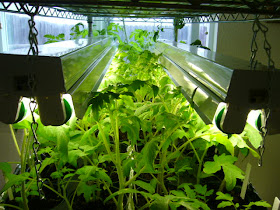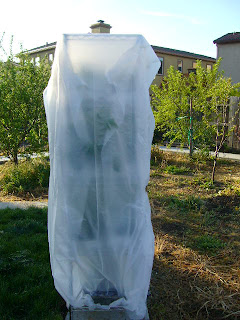 |
| Heirloom Tomato Plant Starters Under Cover |
One of my favorite Clint Eastwood movies from all time would have to be Heartbreak Ridge. I simply cannot get enough of Eastwood's character. I find myself invariably repeating lines from time to time, as you may have guessed with the title. When it comes to the Bird 2013 Heirloom Tomato plant starters? Gunny has indeed, "moved them out.
You'll notice that this year's crop of heirloom tomatoes, sweet and hot peppers, five varieties of basil, three varieties of eggplant and numerous flower plant starters are covered by a thick plastic sheeting. This is for their protection. This is the all important "hardening off" time for the starters that Venus and I planted from seed last February. This also happens to be a new addition to the hardening off process.
 |
| Basil Plant Starters |
One wrong move during this process can result in exactly 120 DEAD AS A DOOR NAIL plant starters. It's either DEAD or severely sunburned and shocked to the point where it will take weeks to recover, resulting in the loss of precious growth time that vegetable plants need to become healthy, large and, ultimately, productive.
I did my best job of hardening off tomato starters during the first year that I planted tomato varieties from seed. That was 2003. I started exactly two varieties that year -- both Livingston originals. I'm not exactly sure what I did right, but I grew 12 champion starter plants that spring. It was pretty darn close to nursery quality.
 |
| Paragon Starters: 2003 |
Call it beginner's luck I guess, because I've never been able to duplicate that success. Hardening off tomato and vegetable plant starters can be difficult for folks who work a full work week, which would include me and the wife that is Venus. The "hardening off" process involves moving plants into sunlight for a few hours each day, then moving them back under cover, away from the harmful UV rays that result in sunburn and shock.
The hardening off process, if done correctly, results in tomato and vegetable plant starters that are completely hardened off and resistant from UV rays in about a week's worth of time. Done incorrectly? A whole host of problems can develop. And I've managed to experience most of them as I majored in gardening errors.
 |
| Vegetable Plant Starters |
Bottom line? We simply don't have the time to move plants into sunlight and back under cover over the course of a five or six day period. If we're lucky? We get three days. On the fourth day when both of us return to work? It's a case of "you're on your own, fellas." I can't begin to tell you the disappointment that washes over me when I see the results of this rushed process pop up a day or two later and worsen over time. Leaves that were once lush, healthy and green turn a none-too-pleasant shade of brown and curl up and die. Starter plants wilt. New growth slows to a crawl.
Although the plants do eventually recover, time has been lost. Worse yet, some plants will recover and grow but not fruit much during the summer. Growing heirloom tomatoes, as I've come to find out, is really hit and miss. Some plants fruit up a storm, while others planted right next to them do very little. Or worse yet, produce fruit that is eventually lost to Blossom End Rot (BER) or other disease.
I'll admit, it's frustrating.
 |
| Some Good Advice? |
But this year? This year represents a new hope in the hardening off process. It is the result of some very good advice from a retired rocket engineer turned heirloom tomato grower who lives in New York and posts on gardening forums under the name of "Hotwired." I tend to trust retired engineers like my father-in-law who passed away a few years ago. I've never forgiven him for doing that. I wasn't quite ready to let Gale go. I guess we never are when it comes to people who make a meaningful impact in our lives.
I was immediately drawn to the title of one of Hotwired's articles titled "Harding Off Tomato Plants for People Who Work Full Time." His suggestions took me into an area that I never would have dreamed of going. It was a simple fix, really. And since he practices this method with great success, why not give it a try?
 |
| Plastic Sheeting |
His advice was aimed at growers who produce 50-500 plant starters, not the novice beginner who is growing out tomatoes for the very first time. His suggestion? Purchase rolls of plastic sheeting found in the paint departments of any big box or hardware store and cover the plants for at least five or six days. At first I was a bit dubious. There are many types and sizes of this sheeting. If you've ever painted your own house before (never again!), you go through miles of this stuff it seems.
Hotwired's advice was quite specific. The plastic sheeting, sold in thickness that ranges from 1 ml to 6 ml, would have to be at least 4 ml in thickness. His instructions promised that as long as the plants are covered with 4 ml plastic sheeting, it would result in starter plants that were completely hardened off within five or six days.
 |
| 2013 Bird Vegetable Starters |
Color me interested. A solution like this had never dawned upon me before. I shared this advice with other gardeners, who also found it unique, but also believed it just might work. Gardening is, after all, a gamble and leap into the unknown. Why not give it a try?
As you can tell by the numerous photos above, it was high time to move the starters outside anyway. They had grown quite large and lush during the month of March in a room that doubles as our home office. Plus, the weather has been just a tad strange this year. Our winter came to a rather abrupt end in January. It turned moderately warm in February, and other than a couple of spring rainstorms, it's been downright pleasant.
 |
| Wire Rack with Wheels: Genius! |
Home Depot offered two types of 4 ml sheeting. One roll came in a size that was three feet long and 50 feet wide. The other, larger roll, offered enough 4 ml sheeting to cover our entire house. I went with the cheap option because, well, I'm cheap. After an investment of $12 bucks, I was at home taping sheets together with duct tape. You thought those were racing stripes? Hardly! It's called the cheap man's way to harden off vegetable plant starters. Three feet wouldn't be wide enough to completely cover our four-foot wide and six-feet high, tiered gardening rack. But two three foot sections taped together with duct tape offered the cheap dude's solution.
The first problem we faced, which I'd given some thought to, was the wind. I had believed that the rocks that I placed on the bottom rack of our tiered gardening rack would be enough. WRONG! A rainstorm blew in the next day and left the sheeting on the other side of the yard. Meanwhile? Our tomato starters were getting pelted with a spring rain. Back underneath the patio they went.
 |
| A Jumbled Mess! |
By the way, there's nothing quite like getting out in the middle of a severe downpour right after you've woken up for the upcoming workday. It works better than a strong jolt of java. But, I digress.
Fortunately, I still hadn't cleaned up from last spring's addition of extra sidewalk space in the Bird Back 40. There were heavy chunks of concrete to be found. I would discover that putting heavy chunks of concrete on top of the gardening rack, as well as the bottom rung, would be solution to our "wind and rain" problem.
One might point out that I've constructed a "mini-greenhouse." Perhaps. But not quite. The sides to this plastic sheeting contraption are not banded together. There's plenty of air circulation that blows through. And although the flaps to this contraption will sometimes blow open, exposing the starters to the dangers of direct sunlight, they quickly close up again.
So far? There's been no telltale sign of sunburn. The plants are green. The plants are lush. They do require daily watering now (they tend to dry out rather quickly in full sunlight, covered or not). But I haven't lost one to sunburn. There's been no wilt or any other problems that come with not hardening off plants correctly.
The big test, of course, will come on Tuesday or Wednesday when the cover is removed and the starters are exposed to the direct rays of warm sunshine. And, yes, it's supposed to be quite warm, with temperatures approaching 90 degrees by the middle of next week.
Will this solution work? Only time will tell. But if it does, Clint Eastwood would approve.


Very nice and good idea. I didn't start anything from seed this year as I'm too busy to tend to them. This year I'll buy and plant.
ReplyDelete